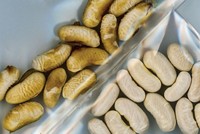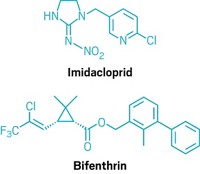Advertisement
Grab your lab coat. Let's get started
Welcome!
Welcome!
Create an account below to get 6 C&EN articles per month, receive newsletters and more - all free.
It seems this is your first time logging in online. Please enter the following information to continue.
As an ACS member you automatically get access to this site. All we need is few more details to create your reading experience.
Not you? Sign in with a different account.
Not you? Sign in with a different account.
ERROR 1
ERROR 1
ERROR 2
ERROR 2
ERROR 2
ERROR 2
ERROR 2
Password and Confirm password must match.
If you have an ACS member number, please enter it here so we can link this account to your membership. (optional)
ERROR 2
ACS values your privacy. By submitting your information, you are gaining access to C&EN and subscribing to our weekly newsletter. We use the information you provide to make your reading experience better, and we will never sell your data to third party members.
Food Science
Slow-release nitrogen fertilizer could increase crop yields
A new nanoparticle-based fertilizer delivers plant nutrients efficiently and reduces the harm of agricultural runoff
by Katharine Gammon
February 22, 2017

Nitrogen fertilizers—used to grow crops around the globe—have a problem. After they’re applied to soil, more than three-quarters of their nutrients get washed away before plants can absorb them. That wastes money and creates environmental messes downstream. Now, researchers have used nanoparticles to create a potential solution: a fertilizer that releases nutrients over a week, giving crops more time to absorb them (ACS Nano 2017, DOI: 10.1021/acsnano.6b07781).
Urea is a common nitrogen source in fertilizer, but it quickly breaks down into ammonia, which rainfall quickly flushes away. To account for that loss, farmers need to apply extra fertilizer to crops, which is expensive—especially for developing regions of the world where food supplies are unstable and populations are growing. Ammonia also can lead to harmful algal blooms in waterways and can enter the atmosphere as nitrogen dioxide, a potent greenhouse gas, says Gehan Amaratunga, an engineer at the University of Cambridge. Fertilizers that slow down the release of urea have multiple benefits.
Slow-release fertilizers are available and consist of urea coated in water-insoluble sulfur or polymers. Such fertilizers reduce runoff, but they are expensive for general agricultural use and haven’t been shown to actually increase crop yield. Amaratunga and his colleagues decided to try a new strategy: They attached urea molecules to nanoparticles of hydroxyapatite, a naturally occurring form of calcium phosphate found in bone meal. Hydroxyapatite is nontoxic and a good source of phosphorus, which plants also need. Similar techniques have been used to create slow-release nanomedicines, Amaratunga says.
In water, the urea-hydroxyapatite combination released nitrogen for about a week, compared with a few minutes for urea by itself. In field trials on rice in Sri Lanka, crop yields increased by 10%, even though the nanofertilizer delivered only half the amount of urea compared with traditional fertilizer. The scientists have also tested the fertilizer with maize, wheat, and tea plants. Amaratunga says the application regime—an initial application, followed by monthly reapplications—mirrors traditional methods of fertilization but requires far less substance.
The cost of making the nanofertilizer is slightly higher than for conventional fertilizer, but that is offset by the reduction in the amount of fertilizer needed—and the environmental benefits of less runoff, Amaratunga says. The researchers say they expect the cost to come down as they scale up the manufacturing processes.
This study’s results are impressive, says Richard Liu, a postdoctoral researcher at The Ohio State University who was not involved with the work. He says most of the studies published in past years haven’t shown whether conventional slow-release fertilizers actually produce more crops. The nanocomposite fertilizer looks more promising than other slow-release options for increasing crop yields and in reducing costs and environmental risks. He expects that this type of fertilizer could be used in most agricultural areas around the globe and on a variety of crops, such as wheat, corn, and soybeans.
With a worldwide population growing to 9.6 billion, people will need creative strategies to grow more food with fewer resources, says Amaratunga. “This is globally relevant, and it’s not really very complicated. It’s one of these innovations where when someone sees it, they say, ‘That’s sort of obvious, but I never thought of it before.’”




Join the conversation
Contact the reporter
Submit a Letter to the Editor for publication
Engage with us on Twitter